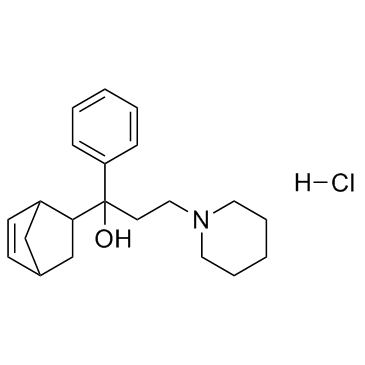Biperidene hydrochloride

Biperidene hydrochloride structure
|
Common Name | Biperidene hydrochloride | ||
|---|---|---|---|---|
| CAS Number | 1235-82-1 | Molecular Weight | 347.922 | |
| Density | N/A | Boiling Point | 462.1ºC at 760 mmHg | |
| Molecular Formula | C21H30ClNO | Melting Point | 101ºC | |
| MSDS | Chinese USA | Flash Point | 224.5ºC | |
| Symbol |

GHS07 |
Signal Word | Warning | |
Use of Biperidene hydrochlorideBiperiden(KL 373) Hcl is an antiparkinsonian agent, which is the selective central M1 cholinoreceptors blocker.Target: M1 receptorsBiperiden is an antiparkinsonian agent of the anticholinergic type. It is used for the adjunctive treatment of all forms of Parkinson's disease (postencephalitic, idiopathic, and arteriosclerotic)[1]. Biperiden has an atropine-like blocking effect on all peripheral structures which are parasympathetic-innervate. It also has a prominent central blocking effect on M1 receptors [2].Biperiden (0.11 mg/kg), benactyzine (0.3 mg/kg),caramiphen (10 mg/kg), procyclidine (3 mg/kg), and trihexyphenidyl (0.12 mg/kg) separately and each in combination with physostigmine (0.1 mg/kg) is to make a comparative assessment of potential cognitive effects. The results showed that benactyzine, caramiphen, and trihexyphenidyl reduced rats' innate preference for novelty, whereas biperiden and procyclidine did not [3].Clinical indications: parkinsonismFDA Approved Date: Toxicity: Drowsiness; vertigo; headache; dizziness |
| Name | biperiden hydrochloride |
|---|---|
| Synonym | More Synonyms |
| Description | Biperiden(KL 373) Hcl is an antiparkinsonian agent, which is the selective central M1 cholinoreceptors blocker.Target: M1 receptorsBiperiden is an antiparkinsonian agent of the anticholinergic type. It is used for the adjunctive treatment of all forms of Parkinson's disease (postencephalitic, idiopathic, and arteriosclerotic)[1]. Biperiden has an atropine-like blocking effect on all peripheral structures which are parasympathetic-innervate. It also has a prominent central blocking effect on M1 receptors [2].Biperiden (0.11 mg/kg), benactyzine (0.3 mg/kg),caramiphen (10 mg/kg), procyclidine (3 mg/kg), and trihexyphenidyl (0.12 mg/kg) separately and each in combination with physostigmine (0.1 mg/kg) is to make a comparative assessment of potential cognitive effects. The results showed that benactyzine, caramiphen, and trihexyphenidyl reduced rats' innate preference for novelty, whereas biperiden and procyclidine did not [3].Clinical indications: parkinsonismFDA Approved Date: Toxicity: Drowsiness; vertigo; headache; dizziness |
|---|---|
| Related Catalog | |
| References |
| Boiling Point | 462.1ºC at 760 mmHg |
|---|---|
| Melting Point | 101ºC |
| Molecular Formula | C21H30ClNO |
| Molecular Weight | 347.922 |
| Flash Point | 224.5ºC |
| Exact Mass | 347.201599 |
| PSA | 23.47000 |
| LogP | 4.70230 |
| Vapour Pressure | 2.45E-09mmHg at 25°C |
| InChIKey | RDNLAULGBSQZMP-UHFFFAOYSA-N |
| SMILES | Cl.OC(CCN1CCCCC1)(c1ccccc1)C1CC2C=CC1C2 |
| Water Solubility | DMSO: >20mg/mL |
CHEMICAL IDENTIFICATION
HEALTH HAZARD DATAACUTE TOXICITY DATA
|
| Symbol |

GHS07 |
|---|---|
| Signal Word | Warning |
| Hazard Statements | H302-H319 |
| Precautionary Statements | P301 + P312 + P330-P305 + P351 + P338 |
| Personal Protective Equipment | dust mask type N95 (US);Eyeshields;Gloves |
| Hazard Codes | Xn: Harmful; |
| Risk Phrases | R22 |
| RIDADR | NONH for all modes of transport |
| RTECS | TN3706000 |
|
Is acute dystonia an emergency? Sometimes, it really is!
Pediatr. Emerg. Care 29(3) , 380-2, (2013) Most cases of acute dystonia are mild and easy to manage; nevertheless, some of them can be fatal because of the involvement of certain muscle groups such as the laryngeal muscles, thus requiring urge... |
|
|
Hemiparkinsonism-hemiatrophy syndrome.
Arch. Iran. Med. 14(2) , 152-4, (2011) The syndrome of hemiparkinsonism-hemiatrophy is an uncommon form of secondary Parkinsonism that presents with unilateral body Parkinsonism plus variable atrophy on the same side. Diagnosis of this syn... |
|
|
Polypharmacy in the treatment of schizophrenic patients in three University Centers in the Federation of Bosnia and Herzegovina (F/BH).
Psychiatr. Danub. 23(1) , 60-3, (2011) Polypharmacy in psychiatry is becoming the rule rather than the exception. Using more drugs at same time usually occurs where single drugs are considered insufficiently effective.The sample consisted ... |
| 1-(5-bicyclo[2.2.1]hept-2-enyl)-1-phenyl-3-piperidin-1-ylpropan-1-ol,hydrochloride |
| 1-Piperidinepropanol, α-bicyclo[2.2.1]hept-5-en-2-yl-α-phenyl-, hydrochloride (1:1) |
| 1-(Bicyclo[2.2.1]hept-5-en-2-yl)-1-phenyl-3-(piperidin-1-yl)propan-1-ol hydrochloride (1:1) |
| 1-bicyclo[2.2.1]hept-5-en-2-yl-1-phenyl-3-piperidin-1-ylpropan-1-ol hydrochloride |
| a-5-Norbornen-2-yl-a-phenyl-1-piperidinepropanol Hydrochloride |
| EINECS 214-976-2 |
| 1-(Bicyclo[2.2.1]hept-5-en-2-yl)-1-phenyl-3-(1-piperidinyl)-1-propanol hydrochloride (1:1) |
| 1-Bicyclo[2.2.1]hept-5-en-2-yl-1-phenyl-3-piperidin-1-ylpropan-1-olhydrochlorid |
| Biperiden Hydrochloride |
| 1-Bicycloheptenyl-1-phenyl-3-piperidinopropanol Hydrochloride |
| a-Bicyclo[2.2.1]hept-5-en-2-yl-a-phenyl-1-piperidinepropanol hydrochloride |
| 1-piperidinepropanol, α-bicyclo[2.2.1]hept-5-en-2-yl-α-phenyl-, hydrochloride |
| 1-bicyclo[2.2.1]hept-5-én-2-yl-1-phényl-3-pipéridin-1-ylpropan-1-ol chlorhydrate |
| Biperidene hydrochloride |
| biperidine hydrochloride |
| Biperiden (Hydrochloride) |